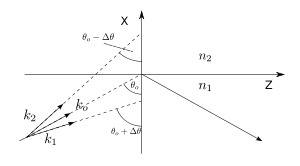Goos–Hänchen effect
The Goos–Hänchen effect (named after Hermann Fritz Gustav Goos (1883 – 1968)[1] and Hilda Hänchen (1919 – 2013) is an optical phenomenon in which linearly polarized light undergoes a small lateral shift when totally internally reflected. The shift is perpendicular to the direction of propagation in the plane containing the incident and reflected beams. This effect is the linear polarization analog of the Imbert–Fedorov effect.

This effect occurs because the reflections of a finite sized beam will interfere along a line transverse to the average propagation direction. As shown in the figure, the superposition of two plane waves with slightly different angles of incidence but with the same frequency or wavelength is given by
where
and
with
- .
It can be shown that the two waves generate an interference pattern transverse to the average propagation direction,
and on the interface along the plane.
Both waves are reflected from the surface and undergo different phase shifts, which leads to a lateral shift of the finite beam. Therefore, the Goos–Hänchen effect is a coherence phenomenon.
This effect continues to be a topic of scientific research, for example in the context of nanophotonics applications. A negative Goos–Hänchen shift was shown by Wild and Giles.[2] Sensitive detection of biological molecules is achieved based on measuring the Goos–Hänchen shift, where the signal of lateral change is in a linear relation with the concentration of target molecules.[3] The work by Merano et al.[4] studied the Goos–Hänchen effect experimentally for the case of an optical beam reflecting from a metal surface (gold) at 826 nm. They report a substantial, negative lateral shift of the reflected beam in the plane of incidence for a p-polarization and a smaller, positive shift for the s-polarization case.
References
- de:Fritz Goos
- Wild, Walter J.; Giles, C. Lee (1982). "Goos-Hänchen shifts from absorbing media" (PDF). Physical Review A. 25 (4): 2099–2101. Bibcode:1982PhRvA..25.2099W. doi:10.1103/physreva.25.2099.
- Jiang, L.; et al. (2017). "Multifunctional hyperbolic nanogroove metasurface for submolecular detection" (PDF). Small. 13: 1–7. doi:10.1002/smll.201700600. PMID 28597602.
- M. Merano; A. Aiello; G. W. ‘t Hooft; M. P. van Exter; E. R. Eliel; J. P. Woerdman (2007). "Observation of Goos Hänchen Shifts in Metallic Reflection". Optics Express. 15: 15928–15934. arXiv:0709.2278. Bibcode:2007OExpr..1515928M. doi:10.1364/OE.15.015928.
- Frederique de Fornel, Evanescent Waves: From Newtonian Optics to Atomic Optics, Springer (2001), pp. 12–18
- F. Goos and H. Hänchen, Ein neuer und fundamentaler Versuch zur Totalreflexion, Ann. Phys. (436) 7–8, 333–346 (1947). doi:10.1002/andp.19474360704
- M. Delgado and E. Delgado, Evaluation of a total reflection set-up by an interface geometric model. Optik – International Journal for Light and Electron Optics, Volume 113, Number 12, March 2003, pp. 520–526(7)